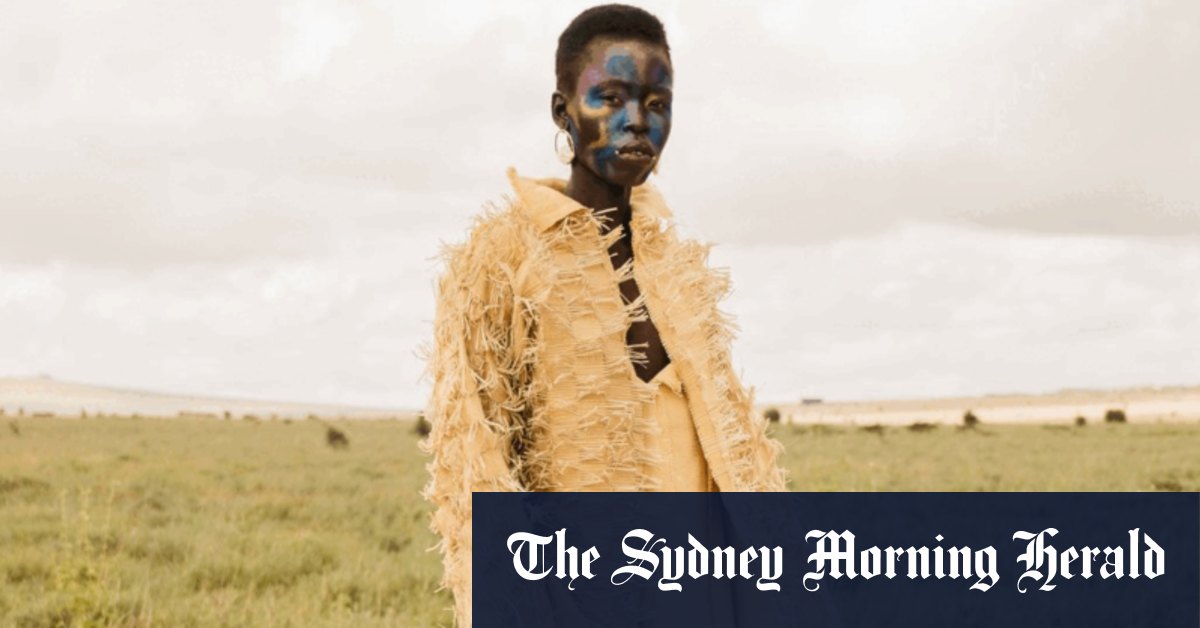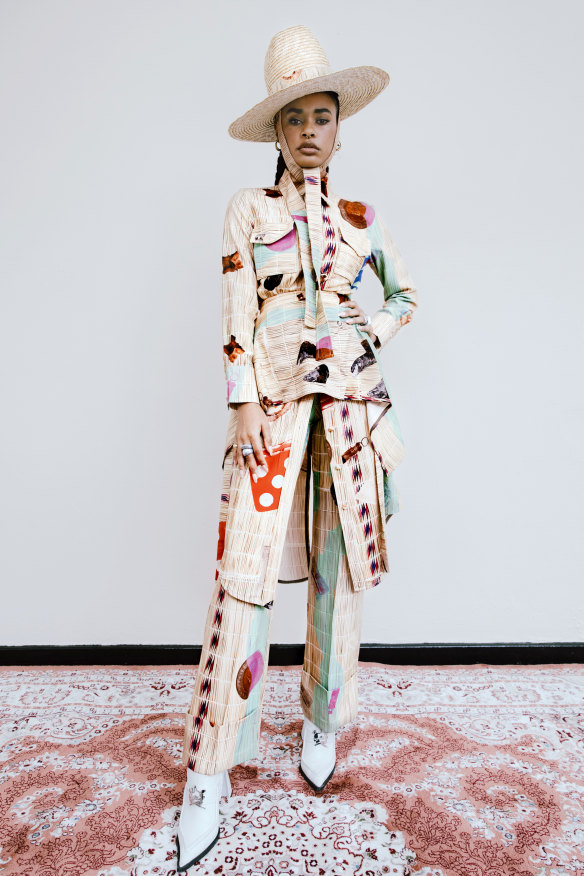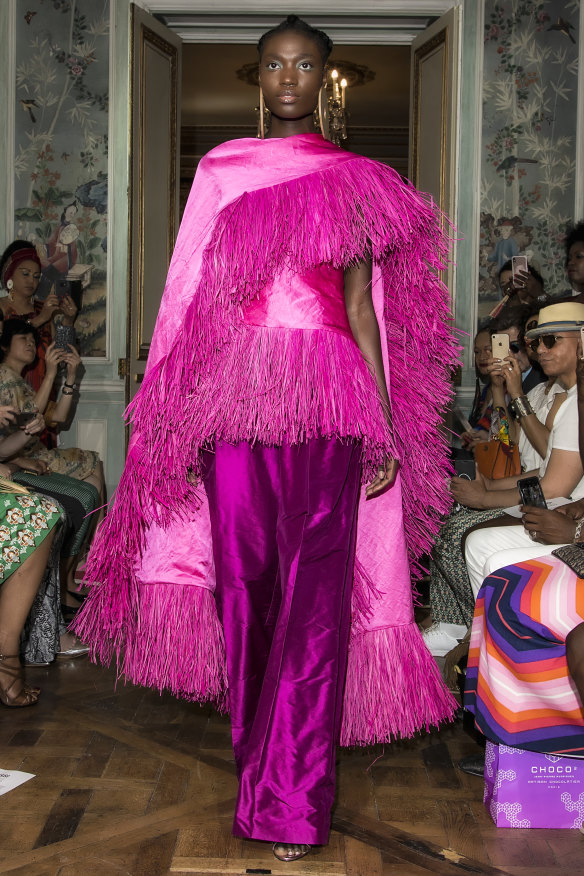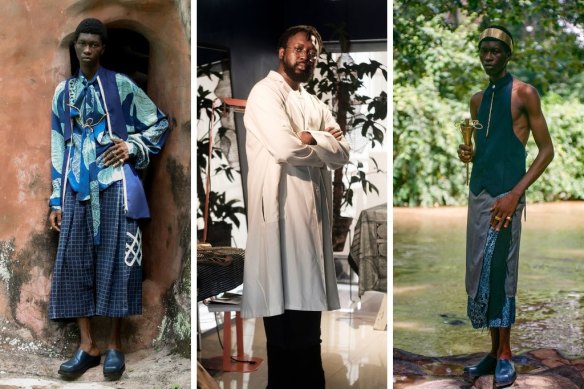Fashion
Fashion needs a revolution. In Africa, it has already begun

What I knew about the extraordinary Bubu Ogisi before a few weeks ago was an embarrassing near-zilch. The Nigerian creative was a scant credit in a short caption under a clip of a quirky little frocklet she’d assembled from loose-linked flat metal hoops (like sheets of arty earrings) that caught my scrolling eye as supermodel Naomi Campbell walked it, tinkling, through a 2023 Victoria’s Secret social media campaign shoot.
I loved everything about it; the kinetic weight and sound of it against Campbell’s skin, its symbolism of divinity, spirituality and womanly power that was puffily explained in the caption. Even its Paco Rabanne-esque echo of Paris past was intriguing.
Naomi Campbell wears Bubu Ogisi’s dress of loose-linked flat metal hoops.Credit: Getty Images
I Googled that frocklet and dropped down a proverbial rabbit hole. From another wondrous frocklet she’d made of watery glass gobbets (ode to Olokun, goddess of the sea) for actress Julia Fox into Ogisi’s amazing life since the early 2010s, jagging back and forth across Africa.
Her collections smack of modernity and layered meanings, mostly in off-beat materials made to ancient African formulas such as Mutuba tree bark cloth, hand made by a thrashing, laborious, multi-step process in the Congo. Raffia, another of her favourites, is a whispering, rustling material common in many African garments and masquerade costumes. She would tell me later: “I want to engage all the senses … raffia when it moves … has a sound like the rain.”
Social media has rocket-fuelled interest in African fashion. Just as consumers are hungering for less planet-wrecking practices, more slow craft, more stories, more meaning in their clothes, lo and behold a whole continent of fascinating designers bubbles into the popular imagination with their modern couture, heritage narratives and pings of art, ancient crafts and naturally embedded sustainable practices.
Ogisi, like many of the designers featured in the Africa Fashion exhibition opening at the National Gallery of Victoria on May 31, is internationally renowned and Africa-focused. She often road-trips around the continent’s 50-plus countries harvesting histories, cultures and political narratives as she goes.
She collaborates with craftspeople on hand-looms and traditional textiles, adornments and accessories in materials from camel bone and native metals to found plastic “yarn”, loading all her learning into her work as creative director, artist, designer, poet, performer and writer of IAMISIGO, her brand now known and shown from Lagos to Paris and beyond. (The name is a blend of “I am” with Ogisi’s surname spelt backwards.)

Bubu Ogisi (centre) with three of her designs from the Chasing Evil collection, AW2020, and Gods of the Wilderness (bottom left), SS2019. Credit: (Main): Diego Asamoa
“I love to describe myself as a traditional contemporist,” Ogisi explains on a Zoom call from Kenya, where she and her crew have paused briefly on yet another research trip. “We use past processes, for the present time, in order to preserve our cultures for the future.”
Her collections are strikingly original and modern, embedded not only with those ancient cultural links, but Ogisi’s subtle modes of protest against colonialism and neo-colonialism. “We’re about decolonising,” she says, “figuring out a new way to marry different worlds; the spiritual world, the physical world, to embrace concepts of borderless society ideologies, and to figure out where the body fits into all this.”
Africa Fashion is a watershed exhibition of 200 exhibits mustered by renowned fashion industry veteran and academic Christine Checinska. She was appointed London’s V&A (Victoria and Albert) Museum’s first-ever curator of African and African diaspora textiles and fashion in 2020.

Stephen Tayo, models holding hands, Lagos, Nigeria 2019.Credit: Courtesy Lagos Fashion Week
“There are some brilliant designers coming out of the African continent and the diaspora who are becoming part of fashion’s vocabulary,” Checinska says via Zoom from London. “Thebe Magugu, Orange Culture, IAMISIGO … so many. They’re on the radar.”
Checinska talks passionately about the African fashion movement as a deep and permanent and industry-altering thing. “They’re not just a flash in the pan,” she says. “They produce these knockout garments that you can understand aesthetically, purely as just brilliant fashion, but they also make you think, prompt you to question your own consumption and the true cost of a garment.
“For the majority of African designers, sustainability is already ‘ground zero’. They see sustainability as about truly understanding the value of skills, the value of people, place and resources and many are quite happy to stay at a certain size to enable them to do that.”

Alchemy collection, Thebe Magugu, Johannesburg, South Africa, AW2021. Credit: Tatenda Chidora
Checinska split works by 50-odd designers from 20-odd countries into two huge sections in the exhibition. One grounds an evocative history lesson straddling the fashion, film, music, literature and arts that African creatives proudly reclaimed and evolved in waves of postcolonial liberation and independence. The next section breaks down contemporary practice by African and diaspora designers, glancing into socio-cultural factors (celebrity spotting, social media) still powering their rise.
Aesthetic stylists are loosely grouped; minimalists to colour-mashing “mixologists”. Exhibits from haute couture by legendary hands to cutting-edge on-trend and riskier experiments pose compelling questions, and invitations to deep dive into their mille feuille of meanings.
Ogisi’s exhibit Chasing Evil from her AW2020 collection, for example, is a sulphur yellow jacket and wide-leg set spiked and fringed with wriggling palm leaf raffia, infused with backstories of Congolese and Nigerian politics and spirituality.
“Of course, there are some people who just want to make beautiful clothes,” Checinksa says. “Not every person wants to draw on a deeper meaning.” But it’s tricky not to fish for them in the warp, weft and Ugandan organic cotton.
Imane Ayissi, for example, the former ballet dancer, now famous Paris couturier, learnt his cutting skills by dismantling clothes that belonged to his mother, Juliene Honorine Eyenga Ayissi, crowned Miss Cameroon in 1960 and subsequently dubbed Miss Independence.

Imane Ayissi, Paris, France Mbeuk Idourrou collection, AW2019.Credit: Fabrice Malard, courtesy of Imane Ayissi
Ayissi’s regal fuscia pink satin set debuted in 2019’s’s and now is a star piece in Africa Fashion. Its three-metre rectangular silk shawl was flat-cut, fairy-stitched with a deep, audibly rustling palm leaf raffia fringe, swathed to layer across the upper body and drop dramatically over pink shot-silk tailored trousers.
“It’s like the coming together of two worlds,” Checinska says. “The textile traditions of the (African) continent … and Parisian haute couture details.”
For London-trained Nigerian-born and based creative Adeju Thompson, fashion without a socio-political sub-strata is an anathema. “This I how want to speak,” he says on Zoom from Lagos, recalling his childhood goal to become a designer. “I realised fashion could be a tool for very serious conversations, it could be a tool for protest, it could be all these things and it could also be very cool to express one’s individuality.”

Adeju Thompson (centre) with two of his designs for Lagos Space Program’s Project 8, Cloth as a Queer Archive, SS2024. Credit: Lagos Space Program
Thompson’s non-binary luxury label Lagos Space Program (LSP) is a “rigorous and dynamic” practice, he says, based on impeccable couture techniques, aesthetics inspired by his own queer experience and the beauty of traditional dress and adornments unique to his indigenous Yoruba people.
Thompson’s runways are enthusiastically lauded, he’s picked up a pool-room of top industry accolades including the International Woolmark Prize 2023, and is regularly counted among the vanguard of African designers dovetailing their practices into global fashion systems.
But there’s a but. “I still get the sense that, ‘oh, you’re from Africa, you’re an interesting idea’,” Thompson observes. “I’m not just the guy who showed in Paris and it was cool but now he’s gone back [to Lagos].”
He worries that gains made in recent years, enabling marginalised ideas and more diversity to mesh in fashion’s mainstream could be lost if the systems and predominantly white US-Euro-centric powers slip into old ways.
“I feel like I want to humanise, celebrate the normality of African experience,” he says. “You know I live in the modern world and tap into spaces that other designers around the world tap into too. I’m not just a fascinating idea.”
Au contraire, he is the future.
Africa Fashion is at NGV International from May 31.









